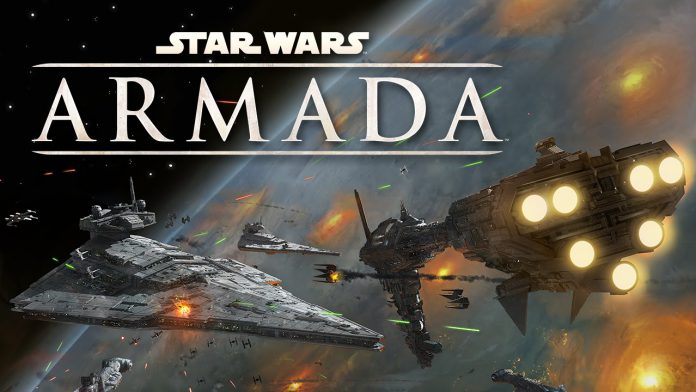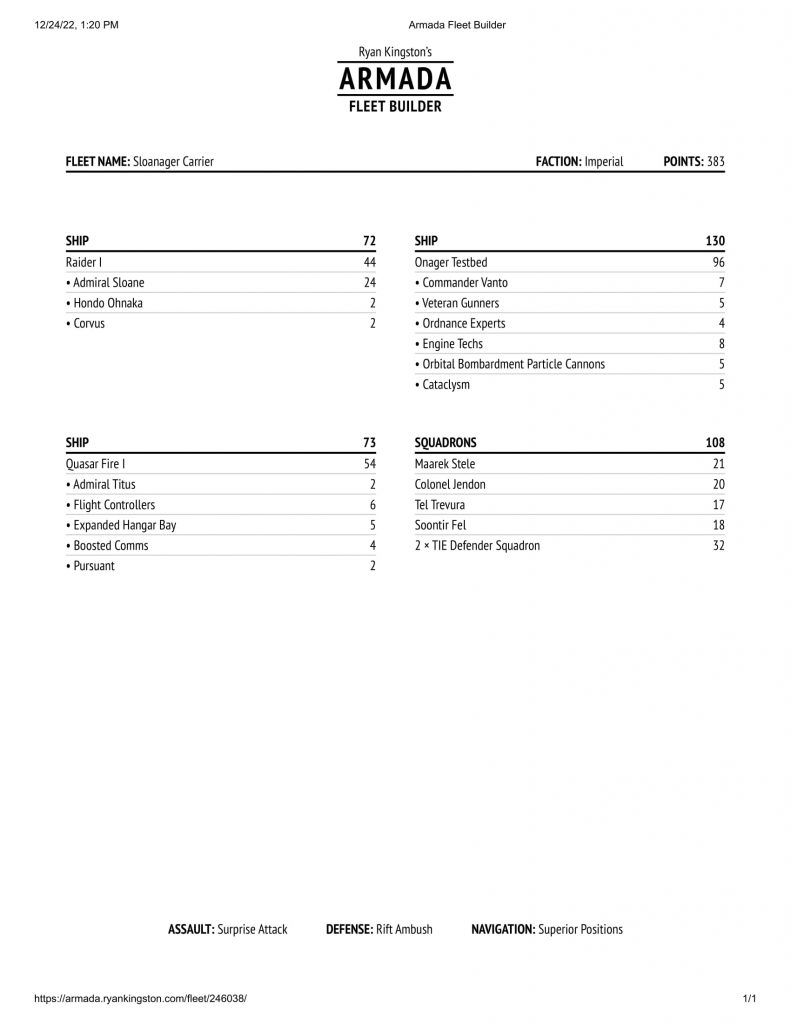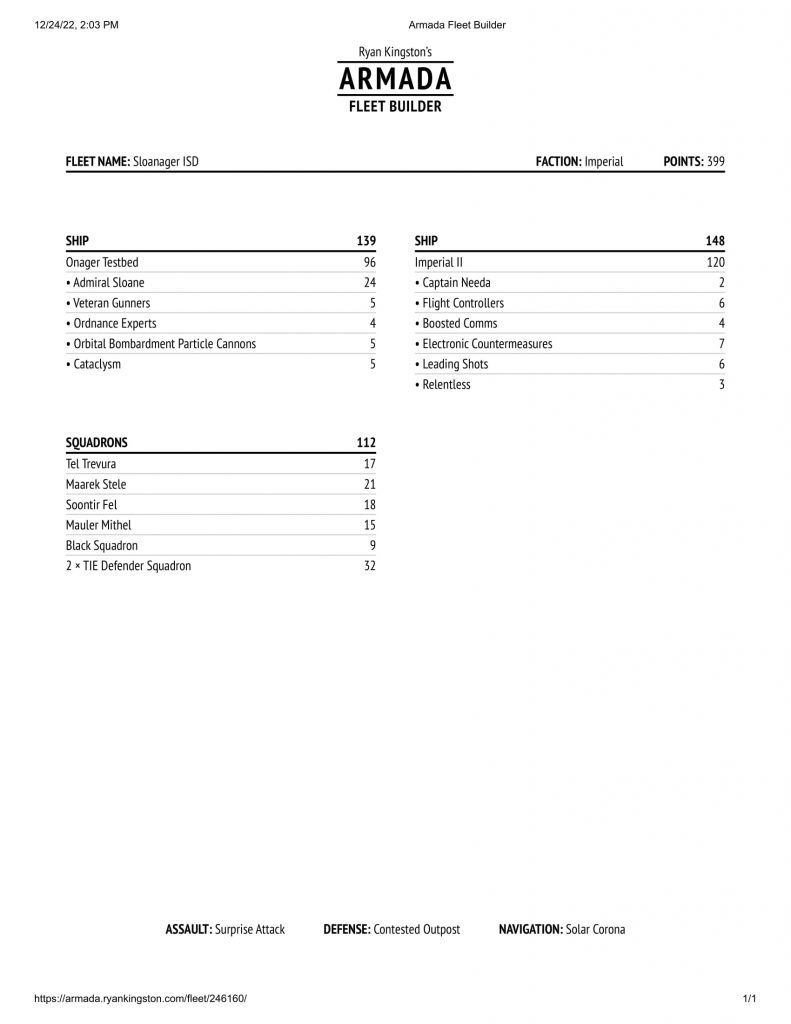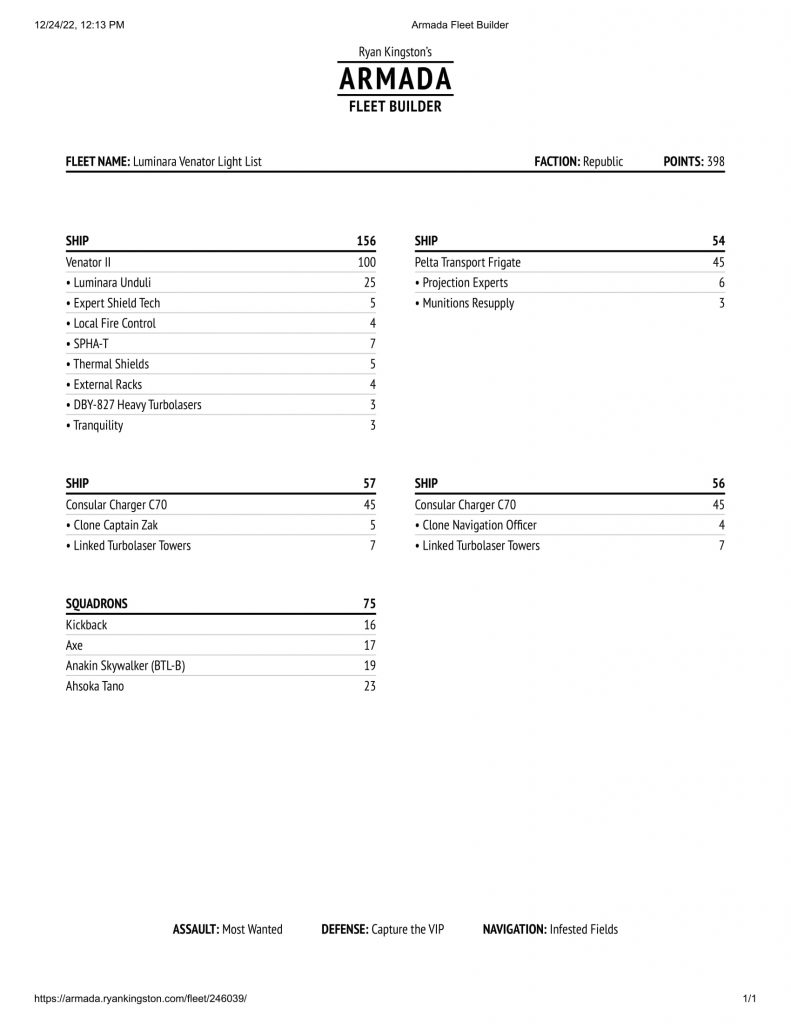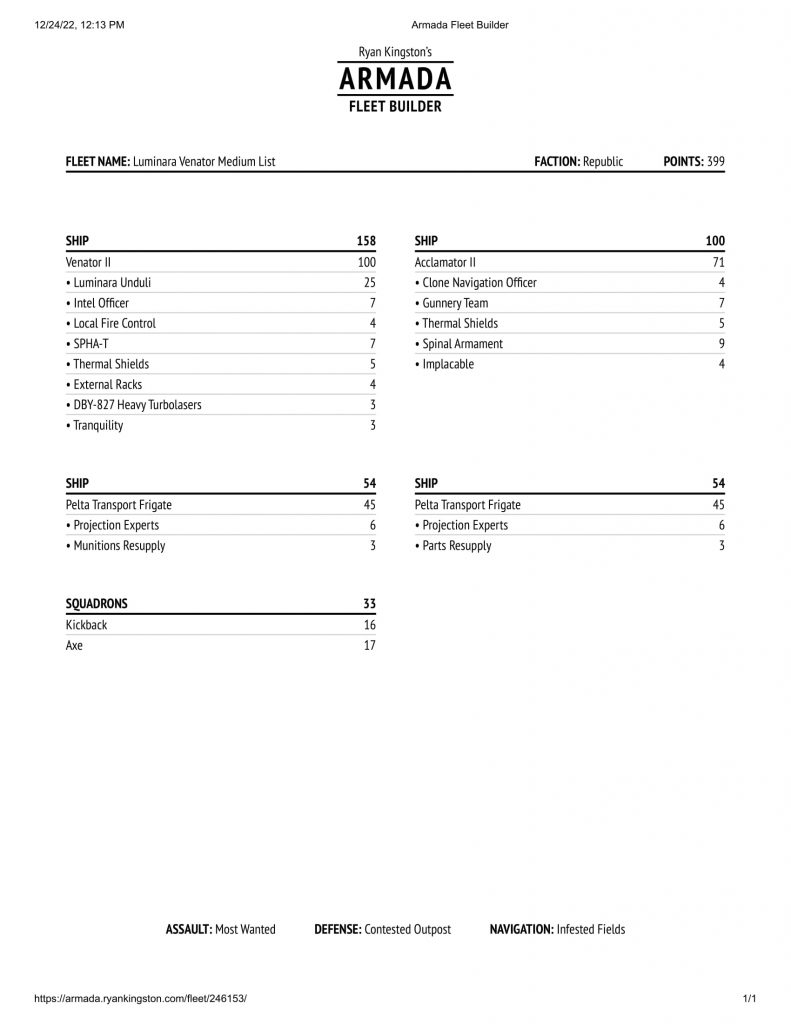I’ve been here for a few months going on and on about Armada. I’ve given faction overviews. I’ve overviewed ships. I’ve given the run-down on dice, and even touched on fleet-building. What about pulling it all together into fleet-building? What if you’re like me playing Hearthstone or Gwent (RIP) and just want to netlist and get something onto the table?
Yeah, I played Face Hunter when it came out. Sue me.
If you netlist in Armada, you’ll probably lose a lot because there’s much more to the game than just the list. However, breaking down lists is a great way to understand how the components fit together into a cohesive strategy, and there’s a lot to learn from that kind of reading. So welcome to List Breakdowns, where I pick two list archetypes and explain their core, options, and overall strategy. If you learn something, fantastic. If it gives you an idea of what list or archetype you want to try next – just as great.
Special thanks to Karneck from SWAE, who maintains rosters of the lists used at many major tournaments. And completely unrelated to that, I had the pleasure of being interviewed by Ion Radio’s podcast, so catch it sometime.
Structure of a breakdown (not the mental kind)
Since this is the first article of this kind, I’ll contextualise my thought processes a bit. The goal of this exercise is to deconstruct Armada list archetypes. This is for my learning benefit and yours, as it allows us to see the core components of a competitive Armada list, grasp the support options, and understand the overarching strategy.
I mainly draw inspiration from tournament lists with no bias to strong or weak contenders. My reasoning for this is that tournament lists are typically well-refined and cohesive. They’ll go through practice games and iterative improvements before the big day, so you can reasonably expect an optimised product. I don’t privilege scoreboard placement, because there are far too many factors that impact placement. Skill gaps, unlucky matchups and fatigue are some of the factors that affect placement outside of the basic list. The goal here is to analyse well-tuned lists, not examine tournament winners.
I’ll discuss lists in an overview format that covers their core components, options and strategy. Wherever applicable, I’ll cover characteristics, gimmicks, and workings. A cohesive Armada list normally has a few non-negotiable components such as the commander and key ships/upgrades, so special attention will be paid to those. Even so, the beauty of Armada is that there’s something to fit every playstyle and the game’s internal balance is fairly strong.
Okay, great. Who’s on the dissection table today?
Sloanager – An Imperial list that uses Admiral Sloane to impede ship defences alongside the Onager’s extraordinary firepower to crack enemies from afar. A nightmare at long ranges.
Luminara Venator – This Republic fleet uses Luminara Unduli’s strong synergy with Venators to lay down heavy fire and stay alive with fleet support. Ship-focused and resolute.
Sloanager – “I’m retaking control of this situation.”
Sloanager has a widely-recognised portmanteau name. This is owing to a period of dominance in the tournament scene where it was a definitive threat that all players had to account for. The list centres on Admiral Sloane, an Onager-class Testbed, and a squadron complement of non-Rogues. The squadrons are used offensively to clear enemy fighters and assault their ships. Sloane’s abilities trigger during these harassing attacks, drastically weakening the enemy’s defences. Onager delivers superweapon-grade firepower to finish the job.
Between mounting fighter attacks, defensive erosion and long-ranged fire, opponents face an uphill battle. The whole fleet – or at least, the Onager – must be destroyed before the opponent can breathe. Conversely, it is inflexible. The Onager is positioned in the backfield to deliver extreme-range salvos, and does poorly against swarms of enemy ships or heavy fire. The fleet’s reliance on Sloane and squadrons also means that breaking those pieces can tip a match.

Core
Commander: Admiral Sloane
Ship: Onager-class Testbed
Non-Rogue Squadrons e.g. TIE Defenders, TIE Interceptors, TIE Fighters, TIE Phantoms and their numerous ace variants
Optional
Ship: Quasar-Fire I-class Cruiser-Carrier and Raider I-class Corvette
OR
Ship: Imperial II-class Star Destroyer
Objective selection
Select objectives that play defensively, force the enemy into range or hinder their mobility. Examples include Surprise Attack; Fleet Ambush; Rift Ambush; Superior Positions
Bid: Variable.
Core Breakdown
Commander
The list is built on Admiral Sloane, so she bears some explaining. Her thing is making non-Rogue squadrons vicious. Lacking the Rogue keyword, these squadrons generally need babysitting from carriers, but Sloane’s rules make them terrifying. When attacking anything with defence tokens, Sloane can use Accuracy icons to spend the target’s defence tokens. Spend means if they’re green (readied), you flip them to red. If they’re exhausted (red), you discard the token. Your opponent doesn’t get that token’s effect. Her TIE fighters can crack through Brace and Salvo tokens on enemy capital ships, or deprive aces of their Scatter. Her spend ability is a massive upgrade over the Accuracy icon’s base effect, because the base effect only targets them for this attack. Spending a token weakens the target for the round (longer if a token was discarded). Defence tokens spent by Sloane cannot be spent by the defender during that attack, but they’re free to spend a redunant token of the same type (Tournament FAQ, p. 12).
Her second rule lets the aforementioned non-Rogues reroll one Critical result against ships. Unless you have the Bomber keyword or one of the rare aces who can use it, the Critical face is a dud for squadrons. She gives those rolls a second chance to land an Accuracy or Hit against enemy ships.
As a squadron commander, Sloane is remarkably interesting in that she doesn’t focus on fighter damage or durability. Rather, she uses them in tandem with damage-dealing ships. Her playstyle encourages a diverse group of non-Rogue squadrons, some aces, and high-damage ships like Star Destroyers and Onagers to deliver follow-up attacks to weakened enemy ships.
Damage dealer: Onager-class Testbed
Speaking of which, the damage-dealing core of the fleet is an Onager-class Testbed. This ship is preferred to its Star Destroyer sibling due to its lower cost. The extra firepower on the expensive version is also moot, since Onagers primarily attack at long-extreme ranges. The ship always has Orbital Bombardment Particle Cannons and Veteran Gunners. Cataclysm is a common pick, and the second Weapon Team slot can be Ordnance Experts, Gunnery Chief Varnillian, or Sensor Team. Taking a Testbed also gives a Support Teams slot for Engine Techs. If you’re building your Onager for the infamous round one shot, there’ll be a backstabbing prick somewhere in the fleet. Hondo doesn’t belong on the Onager because his ability works from anywhere.
The Officer slot is your flex option. Admiral Ozzel is a prime candidate if you absolutely want to secure a first round Ignition shot. Otherwise, Commander Vanto is a fabulously expensive option that can feed the Onager with Concentrate Fire tokens to fire its spinal weapon forever. Vanto can also produce other tokens at will, making him a flex option in a token hungry fleet.
The fit is straightforward, although you’ll want to commit the Ignition Attack rules to memory. The first-round shot variant has Hondo passing the Onager a Concentrate Fire token to fuel its Ignition attack, and Cataclysm giving an earlier window to place the Ignition targeting token. If your opponent has the misfortune of playing your objectives, then Surprise Attack and Fleet Ambush can expedite their demise by deploying their ships in range. Getting nailed by a first-round, large ship attack is a major issue in a game where fighting typically starts on round three. Your Ignition attack is full of unreliable red and black dice, so Veteran Gunners give you dice control. A second Weapon Team should always be considered to improve your dice control. Consider Gunnery Chief Varnillian, who pairs beautifully with Veteran Gunners because you can fish out the one good result before you re-roll using Veteran Gunners. Swap that die back in later for more damage. If that’s too much, then Ordnance Experts gives you cheap black die insurance.
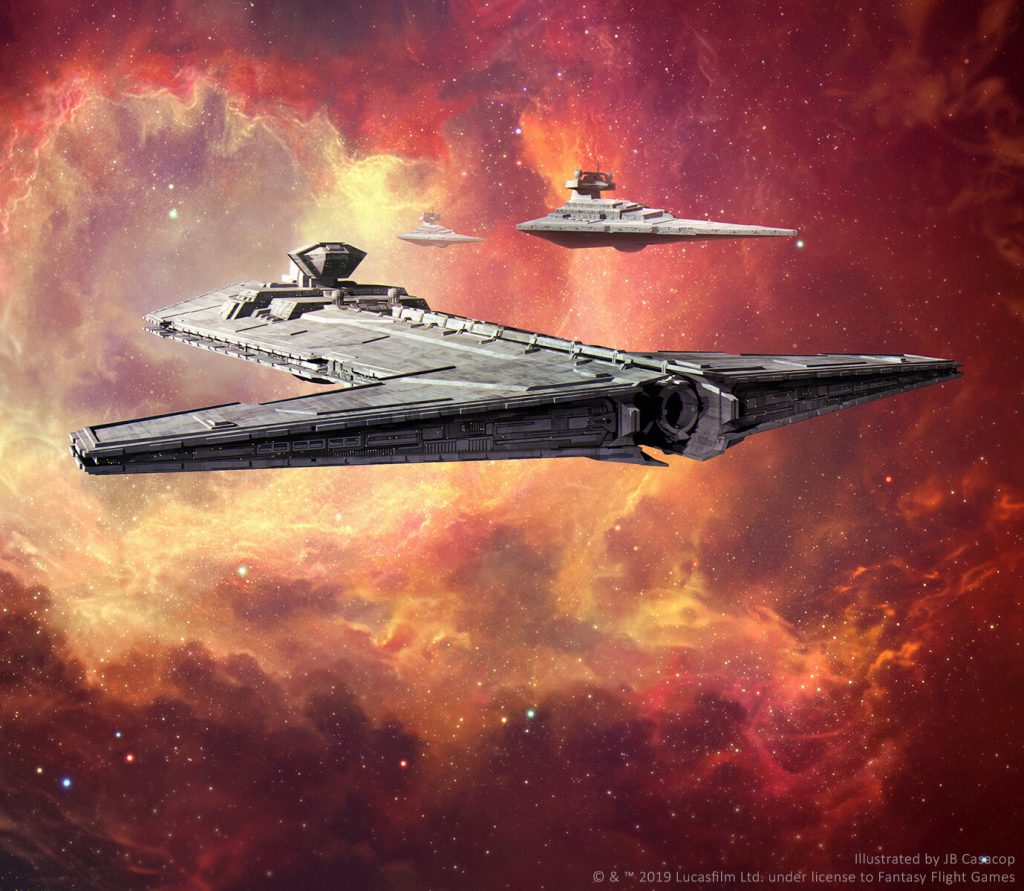
Non-Rogue Squadrons
You need a squadron complement with lots of non-Rogues. One of her favourite picks is the brutal Jendon + Maarek combo. Jendon’s free attack ability is devastating with Sloane’s ability is used against an enemy ship. If you bring Jendon, you’ll want alternatives for Maarek if he gets separated or killed. You’re looking for squadrons with high-damage attacks. Like TIE Defenders. Building into Jendon and TIE Defenders gives you a hard-hitting force for smashing things. Sprinkle in some offensive aces like Soontir Fel or Mauler Mithel to grind through enemy fighters. Your squadron group should be attacking ships, which means you want to kill enemy fighters as quickly as possible. This build is focused on heavy offence and shipbusting. It aims to shatter an enemy squadron screen ASAP, and start hammering their ships with Onager support.
Squadron support focus: Quasar-Fire I-class Cruiser-Carrier and Raider I-class Corvette
This variant uses a light carrier to provide Squadron Commands. Squadron commands nearly double the affected fighter’s effectiveness, and your fleet needs the mobility to chase down capital ships. Slotting Flight Controllers, Expanded Hangar Bay, and Boosted Comms into the carrier is standard. Title and officer are to taste.
Your carrier flies behind the fighters, where it commands from a safe distance (see: Boosted Comms). It multiplies fighter effectiveness during the squadron battle and once that’s sorted, you direct your fighters against their ships. The carrier must be flown perceptively, since it’s made of paper and ranges ahead of the fleet. Your opponent is also keenly aware of the importance of a carrier in a fighter-based fleet and will make it a target.
Taking a carrier is cost-effective and you’ll have space for a Raider. Unlike conventional thinking that positions Raiders as close-combat ships, its only purpose here is to keep Sloane safe and add a ship activation. Sloane’s ability works regardless of where she is in the fleet, and your Onager is a priority target for the enemy. This fleet also invests heavily into a large ship and squadrons, creating a deficit in ship activations. The Raider addresses this. Sometimes, you desperately need a low-impact activation to allow an enemy ship to drive into your Onager’s targeting token. It’s also a limited form of insurance against getting tabled if you lose your Onager and Quasar-Fire, and provides some anti-squadron coverage for your more expensive ships.
The lifeboat Raider is always a Raider I with Sloane aboard. If your fleet has Hondo Ohnaka, he’s here. Fly it in a manner that is protective without being overly cautious.
Assault focus: Imperial II-class Star Destroyer
The Sloanager archetype limits your ship choices due to the Onager and your squadrons taking up half of the fleet. If the light carrier type isn’t to your taste, your alternative is to get heavy.
Very heavy.
Star Destroyer heavy.
The Imperial II gets the role despite its prodigious price tag. It has the combination of a Defensive Retrofit and long-ranged battery fire needed to command fighters and survive away from friendly ships. Fit it with Flight Controllers and Boosted Comms for squadron command. Use Leading Shots as your main source of dice control. Fill the Defensive Retrofit. Early Warning System if your meta has lots of small, weak attacks; Electronic Countermeasures for insurance against heavy hitters; Reinforced Blast Doors for an easy pick. The Title, Officer, and Turbolaser slots are filled or ignored at discretion.
Taking the battlecarrier option sacrifices the carrier and lifeboat for an entire Star Destroyer. You’ll have serious budgetary and mobility constraints, as well as a minimal number of ship activations. What you get in return is a sturdy brick of a ship that provides security to the Onager, and can bludgeon enemies to death with the squadrons. Remember that Sloane uses squadrons to open opportunities for heavier hitters, so adding a second heavy hitter is a very valid choice. This Star Destroyer should be flown more cautiously than the norm. It’s not fitted to the gills to knock out medium and large ships, and Sloane doesn’t benefit the ship itself. It’s a battlecarrier.
Strategy
The overarching strategy should be clear by now. You deploy defensively and hope that you are not forced out of position by the enemy fleet. Your Onager move slowly and sets up its spinal weapon while the squadrons and carrier range ahead. Your fighters swat the enemy squadron group or dodge them to attack capital ships. Sloane’s ability breaks capital ship defences so that the Onager can follow up at long range. Ideally, the enemy fleet should be in shambles by the time they reach your Onager. If not, deal with them accordingly or lose.
Whether you take a bid in your list-building depends on how desperate you are to go first. The carrier and Raider build is incentivised to take a substantial bid. That list is packaged with brutal objectives that allow for defensive play while the opponent runs a gauntlet of fire. Taking the initiative and using the terrain to your advantage is a massive boon, and well worth the cost of a large bid. Conversely, the ISD variant of Sloanager is strapped for points due to the Star Destroyer’s cost. The Star Destroyer can also meaningfully protect the Onager if forced to advance by the opponent’s fleet and objectives. Sloanager + ISD doesn’t necessarily need a bid due to its staying power. Even so, the list still has a clear vulnerability to MSU lists and protecting your core components is vital. Unlike more redundant lists, Sloanager can’t afford to lose many assets before the plan unravels.
That’s an oversimplified version of the plan. It’s not a win-everything netlist, but Sloanager is considered rather unsporting to deploy against an unsuspecting casual player. Played efficiently, the list can handily win tournaments. There’s a strong squadron component, strong damage dealing, strong defences (largely provided by distance), and the whole package synergises beautifully.
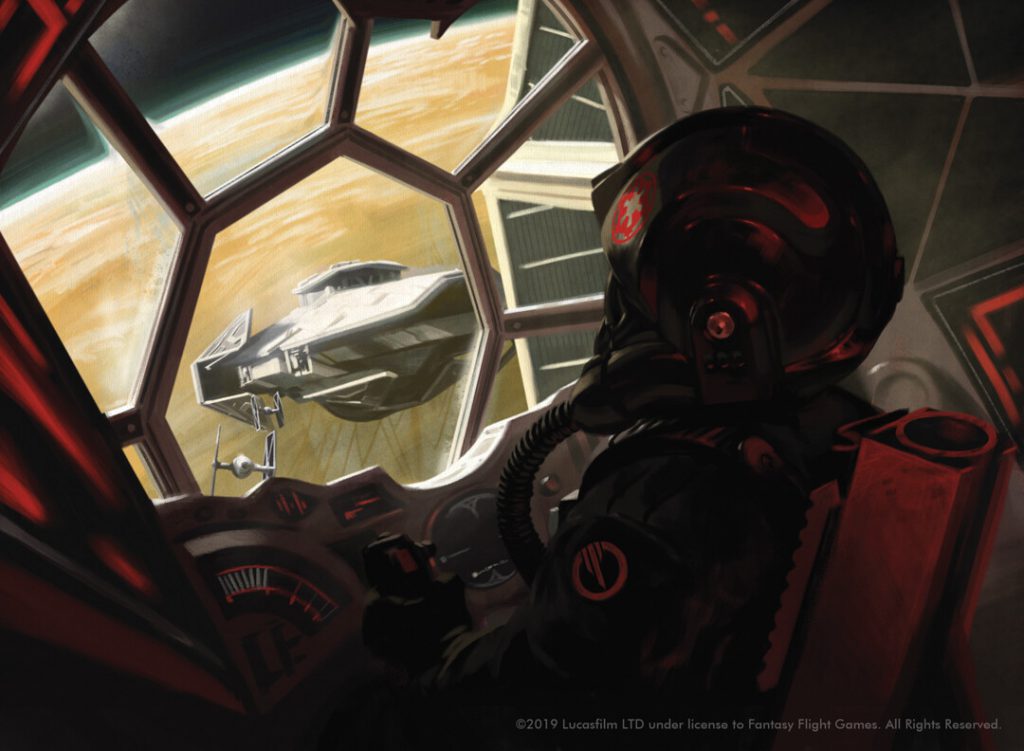
Sample Lists
These sample lists showcase the two dominant Sloanager archetypes. The first is a lightweight version that focuses on ship activations and fighter support through the Raider and Quasar-Fire. It takes a bid for initiative in order to set up a first round Onager shot using Hondo Ohnaka, Admiral Titus, and Cataclysm. This sets the pace for the game: a running gauntlet into heavy fire. The second list replaces fields an Imperial-class Star Destroyer in lieu of small ships to anchor the fighters and deliver firepower. The second list skips the bid and initiative will generally belong to the opponent. In exchange, it brings two threatening large ships and a strong squadron complement to tackle anything.
Neither squadron group is set in stone. The Empire has numerous aces and squadrons to pick from, and any change can drastically alter the group’s performance.
Luminara Venator – “Padawan, terror is not a weapon the Jedi use.”
Luminara and Venators go together like Gregbot and violence. Her ability rewards conservative use of your defence tokens by refreshing other tokens. Paired with the generous range of 1-5 for refreshing them, you have a commander who rewards a discerning approach to defence and coordination. Here, she runs a Salvo build with her canonical Tranquility to combine main battery fire, artillery, and recycling defence tokens to bludgeon the enemy. Her flagship is utterly loaded with upgrades and anchors Peltas and other smaller ships that feed it shields, tokens,and fire support.
This list exemplifies the Republic’s approach to warfare: steady, meticulous, and mutually supportive. It also centres a Republic favourite: the Venator. I’m personally fond of the focused, steady playstyle offered by the list. With enough fleet support, your Venator becomes a porcupine of destruction driven into the heart of battle and it’s capable of enduring almost anything thrown at it.
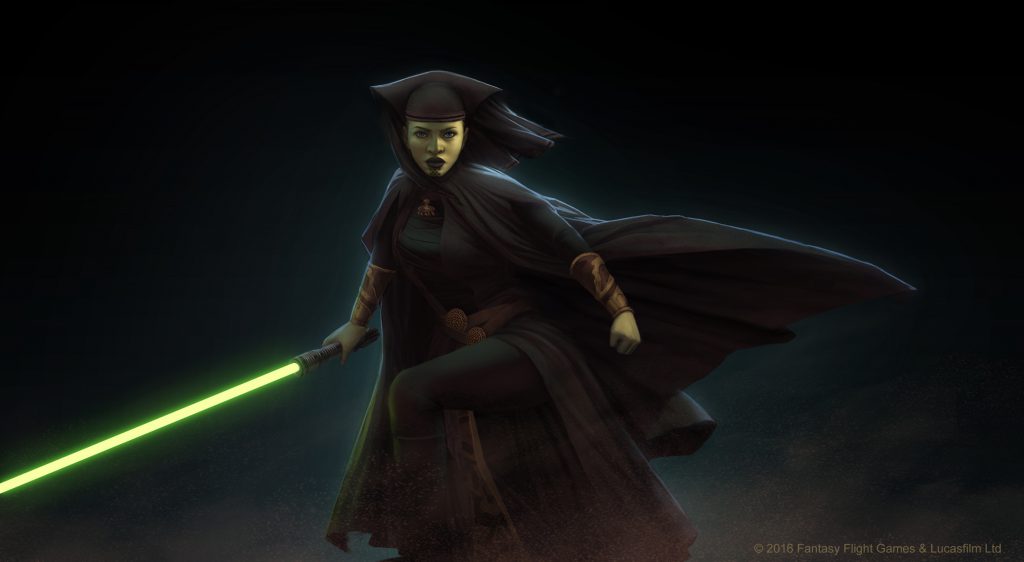
Core
Commander: Luminara Unduli
Ship: Venator II-class Star Destroyer
Ship: Pelta-class Transport Frigate
Optional
Consular-class Charger C70 (escorts)
Acclamator II-class Assault Ship (heavy escort)
Second Pelta-class Transport Frigate (fleet support)
Small fighter screen (light anti-bomber escort, defence token support)
Objectives
Select objectives that reward the use of numerous small ships. Examples include Most Wanted; Capture the VIP; Contested Outpost; Infested Fields
Bid: Minimal or none.
Core Breakdown
Commander
Luminara’s ability requires a bit more finesse than a simple one like Admiral Motti. She can trigger when one of her ships or aces spends 0 or 1 defence tokens while defending (note that squadrons can only refresh their own tokens). If the criteria are met, then the unit may ready (flip from red to green) a defence token that it didn’t spend, or any defence token on a nearby friendly ship or squadron. In a situation where only one token was going to be spent, she gives a massive utility to the fleet. You’ll get best use out of her against piecemeal attacks where your ships and squads weren’t spending more than one defence token anyway. Her ability requires you to set it up by actually spending some defence tokens first.
Luminara fleets play with an emphasis on tempo, or operational pace. They often open a round by spending tokens generously to weather the first crucial attacks. Then, they maintain their tempo by defending selectively to restore tokens on priority units like ships and Scatter squadrons. This is in contrast to most fleets that start a round strongly and deteriorate in defensive strength until the Status Phase. Facing a competently-flown Luminara fleet is fighting an opponent with limitless steadiness and endurance. Conversely, a poorly flown Luminara fleet feels like it has no commander and is stalling its own demise.
Luminara shines in fleets that are loaded with defence tokens. That means warships and aces. Defence tokens tend to mitigate more damage on ships than squadrons, and ships have a greater diversity of tokens to play with. Therefore, fleets built with her are heavy on warships and bring a token group of aces as backup. One of the strongest ways to play her is to put her in a Venator that anchors a fleet of smaller craft.
Fleet anchor: Venator II-class Star Destroyer
This is your centrepiece. Don’t lose it.
You’re taking a Venator II, mostly for its Defensive Retrofit slot. It always has Tranquility, Local Fire Control, SPHA-T, Thermal Shields and DBY-827 Heavy Turbolasers. That’s all-but two slots full of mandatory items. Since the Republic suffers from a firepower shortage, and this ship is guaranteed to be in the thick of it, most players add External Racks for an extra punch. That leaves the Officer slot as your only flex slot. Insert someone appropriate or leave it open and act like you didn’t just spend a third of your points on one ship.
This is very much the Salvo Venator build I talked about in this article. When you pop it on the table, swap that Contain for a Salvo using Local Fire Control. The DBYs are there to make your ship agonising to shoot, and you have a capable defence via Luminara, Tranquility and Thermal Shields. Using this Venator means spending a good number of defence tokens to mitigate the first attack, and then using Luminara to refresh tokens whenever another ship or squadron spends one or zero tokens. If you get the ball rolling, you have an incomprehensibly survivable large ship that always has Braces and Redirects, while one Salvo refreshes the other to keep firing. The combination of SPHA-T, repeated Salvos and External Racks can fill the table with a staggering number of dice.
This build is the hallmark of a strong salvo ship. It’s a ship that derives much of its offensive strength from being shot at. However, it is also loaded with survivability bonuses that allow it to survive long enough to return fire. Beyond the counterfire, it also has SPHA-Ts and External Racks to raise the damage output. Republic ships are deficient in the damage-dealing department and SPHA-Ts address this by converting the Venator’s mediocre four-die side arc into a six-die special arc at medium-long range. Just like Sloanager above, you’ll want to memorise the Ignition attack rules. This ship gets impressive before the shields even regenerate.
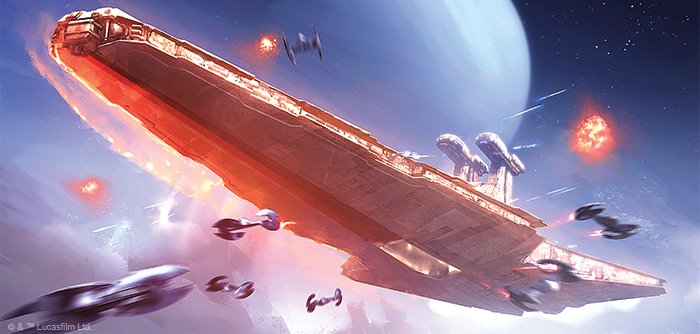
Fleet Support: Pelta-class Transport Frigate
Gearing a Venator to the gills with upgrades is all well and good, but it makes a massive target out of your flagship. Outside of Executors and Starhawks, there aren’t really any ships that can weather concentrated fire from an enemy fleet. Your flagship needs support, so start with a Pelta-class Transport Frigate. That’s the cheaper one. Slap Projection Experts and Munitions Resupply onto it. There. That’s an extra ship activation (with a really good durability-for-cost) that transfers shields to your Venator and feeds it Concentrate Fire tokens to fire the SPHA-Ts. Projection Experts are vital to a competitive Luminara fleet because your flagship will absolutely eat shit. You will use Tranquility’s pseudo-redirect to mitigate damage when using Luminara’s ability. You will need a way to replace the lost shields. You will need Projection Experts.
The Pelta isn’t just a way to repair your flagship’s shields and reload its SPHA-Ts. It’s so much more than that. It’s a chunky little ship that can achieve objectives if you’re second player. You did pick objectives that benefit having small ships. Right? It’s an extra ship activation. It’s a healthy source of anti-squadron flak. It’s a roadblock to impede flankers and if necessary, ram enemy ships. Bringing a fleet support Pelta leverages the Republic’s greatest strength: cost effective hulls.
Optional
Consular-class Charger C70
A great primary damage dealer shouldn’t be your sole damage dealer. This is doubly true if you go first and are playing to a disadvantageous objective. Consulars are the Republic light attack ship par excellence, and your first one will always have Linked Turbolaser Towers and Zak. After the first, it’s usually Linked Turbolaser Towers and your choice of officer. Refer to this article for elaboration.
Acclamator II-class Assault Ship
Adding an Acclamator swings this fleet to the heavier end of the scale. The Acclamator II’s anti-ship performance is favourable due to the combination of longer range and a Defensive Retrofit, so take it up if you’re looking for a heavy escort or second-line support ship. Just be mindful of the fact that Luminara’s playstyle relies on having a large number of cheap defence tokens to spend to trigger her ability on more important targets. The Acclamator a small ship that can refresh your tokens, but is a drain on your ability to refresh them. Gear it out with your choice of ordnance or turbolaser upgrades and remember to use that Defensive Retrofit.
Pelta-class Transport Frigate
A second Pelta. Still cheap. More activations. More ways to refresh the defence tokens on your flagship. More Projection Experts. Not daring enough? Give it Parts Resupply instead of Munitions Resupply so that it can pump a different kind of token. Another cheap support ship for a flagship that needs it. Genius.
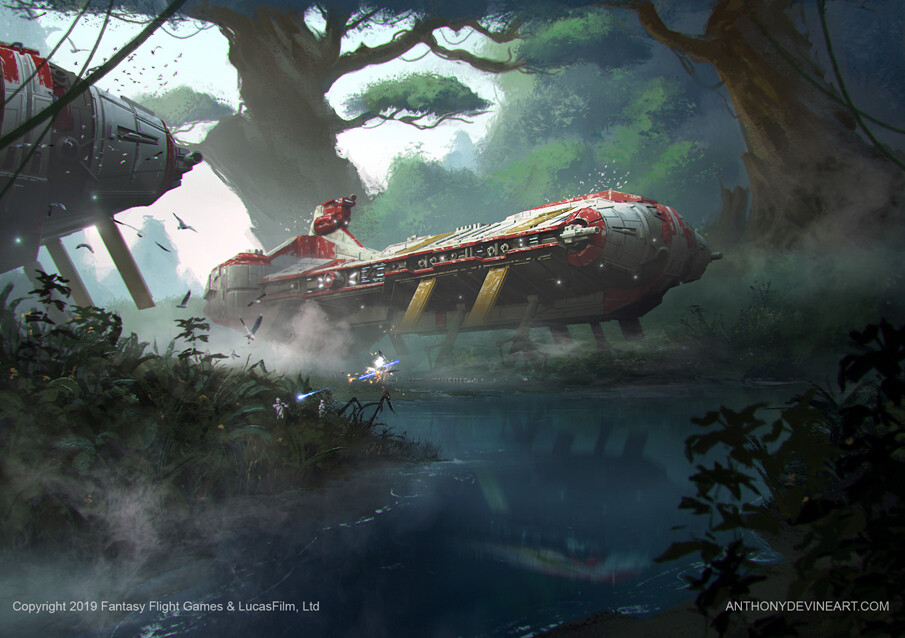
Small fighter screen
You shouldn’t have many points left at this stage. Whatever is left goes into cheap aces to keep using Luminara’s ability. Axe and Kickback are the cheapest Republic aces and bring the useful Escort keyword. Together, they add four defence tokens to your fleet that you can use to refresh your ships’ tokens. After Axe and Kickback, Anakin’s Y-Wing is a good candidate for his price, if nothing else. I was kindly corrected by a Reddit user who pointed out that Anakin’s (Y-Wing) ability does not trigger Luminara because it does not activate while defending. Even so, he’s content with leaving Axe and Kickback to tie up enemies while he runs off to bomb a ship. The fourth pick is a choice of Ahsoka Tano or other Anakin. Nearly tied in price, Ahsoka is a better support option while Anakin’s Delta-7 bludgeons enemies to death. Until he gets nerfed, Delta-7 Anakin is probably the more competitive pick.
Given the other options available, I don’t generally consider Kit Fisto. His lack of a Scatter and high cost pushes him out of the running in a fleet that demands cheap squadrons for defence token proliferation. Oddball is right out due to the ARC-170’s demand for carrier support. The fighter screen in a Luminara fleet is there to keep your flagship from being whacked off the table by a bomber group. At worst, it’s a speed bump and at best, it keeps Luminara alive long enough for Pelta flak to come to the rescue. They also spend their numerous defence tokens to keep Luminara’s ship defences at peak performance. Their role is supportive and doesn’t extend to coordinated bombing runs.
Strategy
Luminara Venator is a list with several moving parts that requires some practice to grasp. The foundation of the fleet is straightforward: the flagship is a beatstick. Use your support ships, defence tokens and squadrons to support it. In reality, the list must be captained with grace: take care not to under or over-spend your defence tokens. You have to maintain formation so that ships and aces are in range to use the token refresh. You have to manage the positioning of your support assets. And if the flagship falls, things go downhill fast.
The Venator is the heart of your list. It will fly at the most opportune target (NOT the centre of their fleet) and begin wrestling it. The flagship spends its tokens aggressively and relies on support ships to keep the shields up and keep the tokens refreshed. The rest of the fleet plays defensively in relation to the flagship, but proactively in relation to game objectives. Whether it’s grabbing the VIP or killing a bounty target, you want to prioritise controlling the board and attacking the objective while the Venator pins the enemy down. This list enters the game with no bid, meaning you’re likely to be at the mercy of your opponent’s objective selection. It handles unfavourable situations well through a mix of flexible, smaller ships and a keystone large ship. Nonetheless, it struggles to screen against enemy fighters and you’ll be relying on Luminara’s ability a lot to resist piecemeal fighter attacks.
I like this list because there’s room to use most of the Republic ship roster in it. Once you suss out your playstyle or local meta, you can tailor it to be heavier with an Acclamator, lighter with Peltas and C70s, or add aces to taste. Luminara Venator is a paragon of Republic fleets: steady, cohesive, and durable.
Sample Lists
These lists show two variants of the Luminara Venator fleet. The Venator’s loadout is largely static, but the forces that support it can change drastically depending on needs and playstyles. Rolling up with a Pelta and two Consulars is a great way to control the battlespace, but you like the specialised, local firepower of an Acclamator. The Acclamator variant of the list requires an extra Pelta to give shields to the new warship. The list is tight on points, and can’t really afford to take a bid.
Conclusion – “We have not surrendered, we do not concede the stars.”
I smashed the draft for this one in a single day because it was so fun to write. I love analysis, reading and number crunching. I’m a filthy netlister, armchair warlord, and I don’t care. I’m happy to receive corrections and feedback from people who’ve actually flown these lists competitively. But honestly, this article was a joy to write because it feels like the culmination of everything else I’ve written. Past the faction overviews and essentials of ship fitting and playstyles and into putting together cohesive, powerful fleets.
2022 was a great year filled with joy and challenges for me. I look forward to 2023, and I hope you have something to look forward to as well.
Summer, out.
Have any questions or feedback? Drop us a note in the comments below or email us at contact@goonhammer.com.
